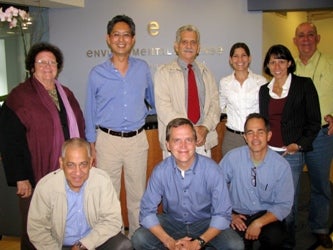 At a recent meeting in Destin, FL, where members of our Gulf and South Atlantic teams met to discuss collaborative projects, I had the opportunity to see a commercial boat offloading its catch after a three day fishing trip. What an experience!
At a recent meeting in Destin, FL, where members of our Gulf and South Atlantic teams met to discuss collaborative projects, I had the opportunity to see a commercial boat offloading its catch after a three day fishing trip. What an experience!
As multitudes of red snapper, vermilion snapper, and grey triggerfish were loaded off the boat and put on ice, I took the opportunity to meet with the Captain and crew and ask questions. I learned what species are caught together, and therefore which species probably share the same habitat.
The Captain told me about the places he goes fishing, what depths he fishes, what gear he uses, and how far out he goes. It was interesting to learn that many of the species he co-catches in the Gulf are same species that are caught together in the South Atlantic. It reaffirmed for me, from a shared habitat and ecosystem point of view, that collaboration between the South Atlantic and Gulf teams is beneficial and even critical.
The Captain explained that he is pleased with the recent red snapper catch share program because he doesn’t have to go as far to catch fish since the red snapper stock seems to have expanded. He also doesn’t have to throw nearly as many fish back overboard. His job is more profitable and takes less time. Who wouldn’t be happy with that?
Additionally, a National Marine Fisheries Service biologist was on hand taking otolith (ear bone) samples from fish to take back to the agency’s lab. This random sampling of otoliths was taken in order to determine the ages of the fish that were caught. Under a microscope, an otolith has rings on it, like a tree trunk, that can be counted to age the fish. She even showed me how to take an otolith sample!
Overall, I learned a valuable lesson. As a fisheries scientist, it is imperative to get out in the field and ask fishermen questions. As I think about how a catch share program would work for the snapper grouper fishery in the South Atlantic, it is important for me to understand the biological aspects of fish that are caught together and share the same habitat. These aspects must be factored into a successful catch share program.
Fishermen are good at what they do and have insightful knowledge into the oceans they depend upon to make a living. This type of information and insight can’t be learned in a book, sometimes you just have to get out on the docks.
Big news comes from the U.S. Southeast, where the regional fishery management council voted last Thursday to protect what is likely the planet’s largest deepwater coral ecosystem, covering nearly 25,000 square miles, stretching from North Carolina to Florida.










 Last week marked the beginning of a sea change in U.S. and Cuba cooperation on the environment. Our Oceans team invited and secured visas for a delegation of Cuban scientists to come to the U.S. for meetings with EDF and other partners. EDF has been working in Cuba for almost a decade to protect coral reefs, conserve mangroves and other vulnerable coastal ecosystems, and to conduct scientific research with our Cuban partners.
Last week marked the beginning of a sea change in U.S. and Cuba cooperation on the environment. Our Oceans team invited and secured visas for a delegation of Cuban scientists to come to the U.S. for meetings with EDF and other partners. EDF has been working in Cuba for almost a decade to protect coral reefs, conserve mangroves and other vulnerable coastal ecosystems, and to conduct scientific research with our Cuban partners. At a recent meeting in Destin, FL, where members of our Gulf and South Atlantic teams met to discuss collaborative projects, I had the opportunity to see a commercial boat offloading its catch after a three day fishing trip. What an experience!
At a recent meeting in Destin, FL, where members of our Gulf and South Atlantic teams met to discuss collaborative projects, I had the opportunity to see a commercial boat offloading its catch after a three day fishing trip. What an experience!